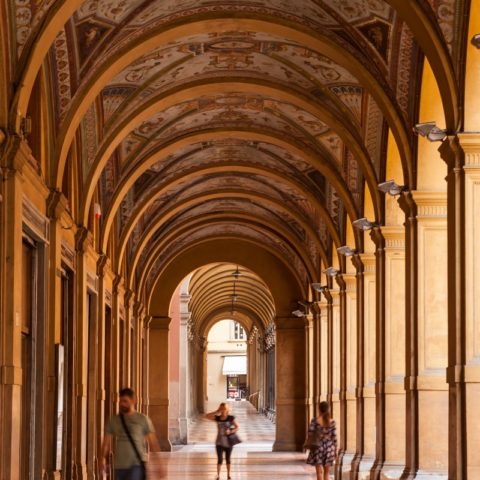The history of the porticoes of Bologna
Expression and element of Bologna’s urban identity: this is how UNESCO, which in 2021 crowned them a World Heritage Site. defines them.
That of the porticoes is an absurd and millenary story, which has led them from being a quick fix to a structural law, and from a structural law to the symbol of the city in the world like the mortadella and the Two Towers. The first porticoes, in fact, arise around the year 1000, more or less in conjunction with the birth of the University, the first in the western world. This nascent institution attracts more and more people to the city: above all students, but also people from the countryside, intrigued by the possibilities that an increasingly in turmoil Bologna could offer. The flow of people brings with it a renewed flourishing of trade, but also the inconveniences caused by sudden overpopulation, such as the problem of the scarcity of available housing.
From abusive to Unesco world heritage
Citizens then begin to make room for newcomers: they do it by expanding the size of their homes, supporting them first with wooden supports and then, when the weight becomes unsustainable, with columns to hold them from below. Soon, people realize that the porticoes allow citizens to meet, trade and shelter from the weather and dirt of the streets: the measure, initially abusive, in 1200 even becomes law, with a notice stating that each building should have to equip itself with its respective porch. The document also specifies the measures: 2.66 meters high and wide (corresponding to 7 Bolognese feet), enough space to allow the passage of a man on horseback. In the middle of 1300, the feet become 10, and the arcades of the new buildings under construction gain further breadth. Initially built in wood, they became in stone or brick only in 1500, and the stratification of periods and styles is still clearly visible in the fabric of the city.
But whitch are the Unesco world heritage?
There is no other city that can count as many kilometers of porticoes in its city perimeter: of the over 53, the most famous are undoubtedly those of San Luca, the sanctuary that guards the city. Its 666 arches and over 3.000 meters in length are Guinness World Record for the longest porch in the world, which clings around the Guard Hill building the allegory of a snake crushed by divine power. But the UNESCO porticoes also include the arcades of Piazza Santo Stefano, those of Strada Maggiore (including the wooden one of Corte Isolani, one of the few remaining of this material), those frequented by university students of Via Zamboni, those of Via Galliera – once the main artery of the center –, Piazza Cavour and Via Farini with their frescoes, and Via Santa Caterina. And then the portico of the Pavaglione, which crosses the Archiginnasio and Piazza Maggiore, those of the MAMbo (the Museum of Modern Art), the Baraccano Theatre, the cemetery of the Certosa and the "train of the Barca”, in the homonymous district.
Find out more about our tours of this wonderful pearl of Bologna!



